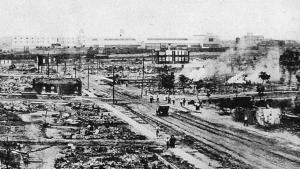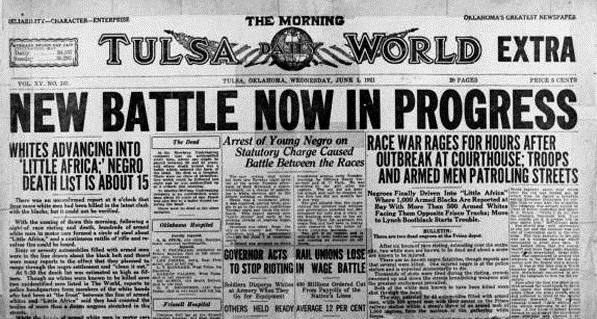In 1921, one of the most horrific acts of violence was committed on not just one, or even a group of black individuals, but on an entire black community of more than 10,000 people.
Undoubtedly, this post may raise the ire of a few ignorant individuals, like our local constable who thinks stating known facts about Italian Christopher Columbus being a slave trader and practicing genocide equates to me, “hating America.”
I consider it, attempting to become more aware.
Unlike her, I read books that educate adult readers – not the ones with pictures for 5th graders. So, for bigots, racists, white supremacists, and others who don’t like the public being made aware of truth, this won’t be pleasing to read.
It wasn’t until Trump decided to make his play for votes by holding a rally in Tulsa, Oklahoma on June 19 that a spotlight was put on the history of Tulsa.
I think by this time, if you watch something other than Fox & Friends, you are aware that June 19 is recognized as the date slavery ended in the United States. Trump’s planned rally is seen as a supportive dog whistle to those many radical followers in his base.
Tulsa, Oklahoma, like any city in 1921, had clearly defined areas where blacks were segregated to and resided. The “Greenwood District” was an economically successful area, boasting banks, churches, pharmacies, movie theaters, restaurants, and hundreds of businesses, all owned by blacks and supported by a black population of 10,000.
Many residents were more financially successful than those across the tracks in the white areas, causing jealousy and anger in the other areas of Tulsa, which had a large KKK membership of approximately 2000.
The Greenwood District was so wealthy in fact, it was called, “Black Wall Street.”
In 1921, failed reconstruction was still being felt, Jim Crow laws were furiously being enacted, and black men were being lynched in our country.
The spark that ignited the racial tension in Tulsa was typical at the time. It involved a black male and a white female.
A 19 year-old black shoe shiner, Dick Rowland, working outside the Greenwood District, has permission to enter a building to use the rest room on an upper floor. He enters the only elevator operated by the 17-year old female, Sarah Page.
She screams, he runs, and she accuses him of assaulting her, despite some who say he tripped getting off the elevator, and grabbed her arm to keep from falling. She never pressed charges, but the authorities decided they would.
He’s arrested and the “assault” quickly becomes a rumor of rape that makes the rounds through the city of Tulsa. A local newspaper writes an inflammatory story the next day.
Tulsa Tribune, ran the headline, “Nab Negro For Attacking Girl In An Elevator.” The local police, aware that such an allegation could mean Rowland would fall victim to a lynch mob, took Rowland into protective custody at the top floor of the Tulsa County Courthouse.
Talk of whites planning on lynching Rowland is received by residents of Greenwood District, but the men of Greenwood aren’t the typical poor blacks in other areas of the country that will do nothing.
They arm, present themselves to the sheriff, and offer to assist him in protecting their resident from the expected mob. He declines their offer, but they remain vigilant outside the courthouse building where Rowland is held.
A white mob gathers demanding the 19 year-old be handed over for an immediate lynching. One white mail approaches with a gun, stating he’ll use it. A tussle ensues and the white male is shot.
All hell then breaks loose.
The blacks eventually retreat back to the Greenwood District with Rowland, to prevent the mob from lynching him.
For a short time the Greenwood District is successful in fending off the white mob at the border of their community, but the mob’s numbers increase, having grown to 3000 and they breach the defenses.
Killing, burning, and looting by whites goes on throughout the Greenwood District for 18 hours. Witnesses reported that military planes took part in the assault, by this time termed a black riot, race riot, and even, race war. The planes dropped nitroglycerine bombs on the buildings, which one newspaper called, “n*****town.”
When it was concluded the local media reported only 39 blacks were killed, but the number is believed to have been more than 300, including women and children.

Even if the number of deaths are to be argued, what’s known for a fact is that 35 blocks, the entire Greenwood District, was systematically burned to the ground, leaving survivors homeless, with thousands corralled into the local fairgrounds.
For a typical denier, they may say this happened almost 100 years ago. Why dredge up a past atrocity?
After all, Trump may tell us again in Tulsa, there were good people on both sides.
The honest reason to bring it up is it goes to the fact that our history is “white washed” and for those of us who are white, we don’t comprehend the feeling of our lives not mattering.
Has much changed in 100 years in Tulsa?
Well, whites aren’t burning down 35 blocks of a city, or openly forming a lynch mob, but according to Business Insider, the attitude toward blacks by at least one ranking figure in the TPD seems to indicate bias, if not systemic racism.
Discussing nationwide protests over the killing of George Floyd by police in Minneapolis, white TPD Maj. Travis Yates offered his opinions when speaking to talk radio host Pat Campbell on his podcast .
Yates expressed displeasure with the largely peaceful protests that have been taking place in big cities and small towns all over the country since Floyd’s killing on May 25.
Yates, despite his timeline being off in the following statement, had more to say regarding the death of George Floyd.
“The officer was arrested the next day. They were prosecuted, they were fired. What are you doing? What do you mean, ‘justice?’ Justice at this point has been done,” Yates said. “Well, then it turned into systematic racism, systematic police brutality.”
Without evidence, Yates alleged that journalists and a group he declined to name have financial interests in lying about policing.
Yates is no stranger to racial controversy. In 2016, he faced criticism for an essay in which he declared American police were “at war” and implied Black Lives Matter activists should not be allowed to visit the White House.
In 2018, he suggested in an open letter to Tulsa Mayor G.T. Bynum that any disproportionate policing in Tulsa’s black neighborhoods was a result of “fatherless homes” and allegations of racism in policing are “dangerous” and a “great scam.”
If that’s a major in the TPD expressing those views, why would anyone expect patrolman under his command not to take an attitude toward blacks that reflects those views, and to act with bias when they interact with them?
UPDATE 6/12: Following the backlash he received, Trump announced he is now rescheduling his Tulsa rally to June 20, and at the request of his “many African-American friends.”
Disclaimer: On January 4, 2016, the owner of WestEastonPA.com began serving on the West Easton Council following an election. Postings and all content found on this website are the opinions of Matthew A. Dees and may not necessarily represent the opinion of the governing body for The Borough of West Easton.







